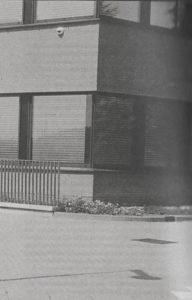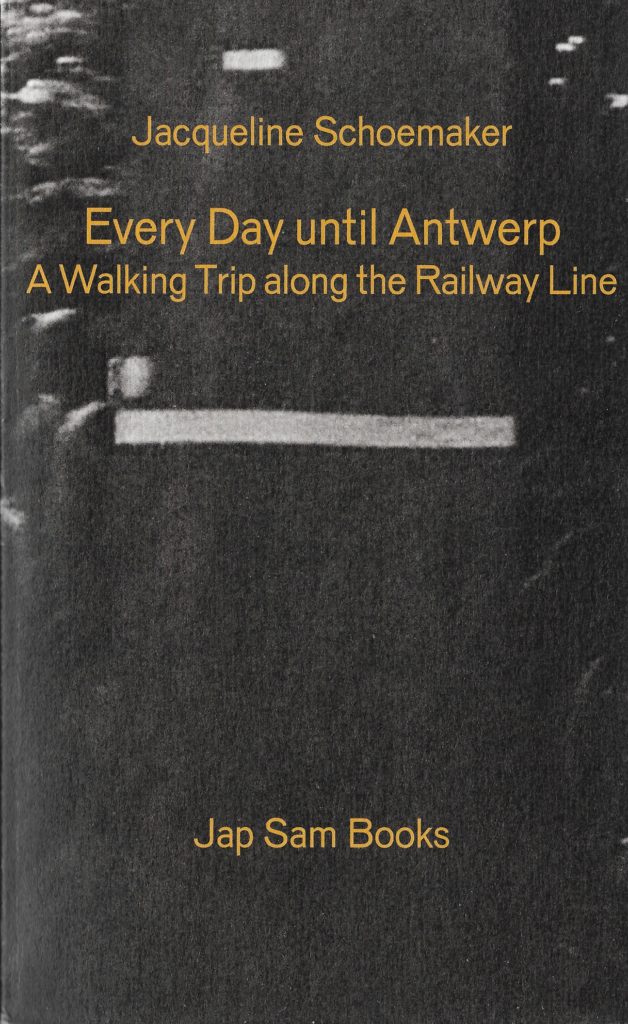Book Review – January 2022
Traffic arteries intersect. Megastores, stench and dust. Trucks thunder along the asphalt towards the motorway. Boels Rental, Esso Express (‘diesel only’). The road slopes upwards and becomes a bridge across the Albert Canal. A monumental panorama of the city is revealed.
Jacqueline Schoemaker is a researcher and writer based in Amsterdam. For twenty years she travelled regularly on the train between her adopted home city and Antwerp, where her parents lived and where she grew up. The trains of the old Benelux inter-city line were invariably crowded, dirty and frequently delayed. They were eventually replaced by a new high-speed service.
Every Day until Antwerp is an account of a journey on foot that Schoemaker made in the summer of 2012, just before the old inter-city line was closed. Her plan was to walk the 150+ km between the two cities, shadowing as closely as she could the route of the railway line. She thought she knew this route well, having made the journey by train on many occasions. But, reflected Schoemaker while she planned this journey, her perception of the route was limited to the view from the train window. She had been a passive observer catching fleeting glimpses of the landscape rather than actually experiencing it by becoming a part of it. Furthermore, the new high-speed line would be faster, have fewer stops and would follow a different route, leaving behind forever the landscape adjoining the old line.
 Schoemaker wanted to experience her journey on foot with maximum intensity. Thus, although it would be easy to hop on a train or bus each evening, spend the night at home and resume from where she had left off the following day, she rejected that idea. She decided she wanted to remain within the landscape for the duration of her journey, sleeping outdoors. If there was a convenient campsite along the way, she would use that. Otherwise she would find somewhere suitable, some liminal space, some leftover scrubby ground between buildings, roads or fields, where she could discreetly pitch her small tent and make herself as comfortable as the circumstances would allow.
Schoemaker wanted to experience her journey on foot with maximum intensity. Thus, although it would be easy to hop on a train or bus each evening, spend the night at home and resume from where she had left off the following day, she rejected that idea. She decided she wanted to remain within the landscape for the duration of her journey, sleeping outdoors. If there was a convenient campsite along the way, she would use that. Otherwise she would find somewhere suitable, some liminal space, some leftover scrubby ground between buildings, roads or fields, where she could discreetly pitch her small tent and make herself as comfortable as the circumstances would allow.
Every Day until Antwerp opens with Jacqueline Schoemaker leaving Amsterdam on foot. Behind her she pulls a shopping trolley containing a tent, sleeping bag and other essentials for the journey. Her narrative deliberately moves along at walking pace describing every pavement, every underpass and every cycle path. We quickly learn that this space between two cities, between two nations, is not designed for humans to traverse by foot Schoemaker frequently has to veer away from her route beside the railway to avoid fenced off buildings, busy roads, canals and other railway lines. This is a flat, intensively farmed landscape, criss-crossed by roads and dotted with occasional industrial units. It is a landscape that is wholly human-designed but, outside the towns and villages, strangely empty.
For the duration of her journey, this is Schoemaker’s world. She describes in detail how she manages to get by: how she buys food and fills her water bottles, where she manages to wash, to dress her blistered feet and go to the loo outdoors. Occasionally she has the luxury of a drink or meal in a café or a shower at a campsite.
The book contains both a Dutch and an English version, back-to-back. Jacqueline Schoemaker, a native Dutch/Flemish speaker, has made the English translation herself. While this results in a text that is not quite as polished as it might be if it were produced by a professional translator, we successfully gain a clearer appreciation of the energy and commitment with which Schoemaker writes. With a translator mediating her words, this might have been lost.
As we follow her journey, the repetitive nature of the landscape becomes apparent: various combinations of road, railway, cycle path, farm, village and industrial come into view, seemingly without end. In between these features in the landscape, however, are spaces that seem to belong to no one and have no particular utility. Schoemaker reclaims these liminal places; she humanizes them by using them as places to rest, wash or answer her calls of nature.
Along the way she meets people who are kind and friendly. Most, however, ignore her, giving no more than a quizzical glance at this strange woman pulling along a shopping trolley. Walking is one of the most natural of human activities. Yet, forms of walking that do not conform with the prescribed norm, such as walking to work or for an approved form of leisure, tend to be regarded as slightly odd.
Jacqueline Schoemaker has produced a very enjoyable and thought-provoking book. She explores the conceptual, temporal, social and topographical possibilities of the act of taking a walk. The highest compliment I can give her is that she makes me feel inspired to make similar journeys of my own.
Jacqueline Schoemaker
Jacqueline Schoemaker is a researcher and writer. Her earlier publications include The Undivided City (2012) and Het failliet van de Javastraat (2017).
Every Day until Antwerp: A Walking Trip along the Railway Line/Alle Dagen tot aan Antwerpen: Een voetreis langs het treinspoor
Jacqueline Schoemaker
Jap Sam Books
2020
UK – £12.95 (paperback)



Thanks Bobby, have ordered this book
I don’t think you’ll be disappointed, Sandy!
It’s arrived, a nice dinky size for walking with.
…. and learning Dutch!
This sounds excellent, and fascinating in a funny sort of way. I can see how you could inadvertently learn Dutch if it was on opposite pages!
Hi Liz. Yes, that occurred to me too; it would be helpful for language learning if each Dutch language page was printed opposite its English translation! This Welsh/English book I reviewed years ago does precisely that: https://psychogeographicreview.com/one-moonlit-night-book-of-the-month-october-2012/
I like this notion of trying fully to experience the places passed through, even those that are outwardly uninspiring.
Yes, walking, especially a long walk, does give one a different perspective.